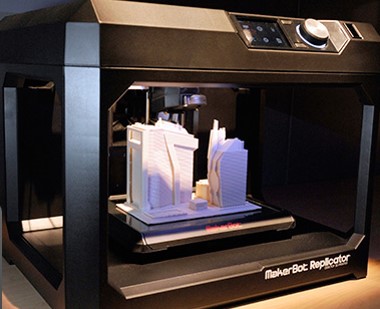The 3D Printing Explosion
by Philip Huerta
The 3D printing industry is experiencing exponential growth. This applies across the spectrum, from hobbyists to entrepreneurs, to companies utilizing it as part of their product development process, and to industrial fabrication. And the trend continues to look bright for this industry. Some of this data comes from the yearly Wohler Report, which reviews the state of 3D printing and the additive manufacturing industry. The 2014 report states that this fast growing industry contributed $3.07 billion in revenue last year, and that in experienced a growth of 34.9% in 2013! This growth in 3D Printing has resulted in the proliferation of 3D printing companies, sites with models ready for 3D printing, and other support technologies. Several contributing factors are discussed below.
COST. Companies have come to realize the cost and time savings in using 3D printing for fabricating early prototypes and for evaluating the final design prior to committing to expensive hard tooling. Many companies have integrated 3D printing as part of their design/development process. An example is AET’s design methodology flow diagram. The additive process of the 3D printing process results in the use of less raw materials as opposed to the “subtractive” (machining) process. Another cost factor is that, in some cases, the use of 3D printed parts and/or assemblies can be functional tested or even used as the final product. This is due to the advances in the higher-strength materials available. According to the Wohler Report, more than 20% of the output of 3D printers is now final products and it predicts that this will rise to 50% by 2020.
FLEXIBILITY. The 3D printing process is design-flexible. By virtue of the additive process of 3D printing, it inherently has the ability to make almost anything, regardless of the complexity of the form. Also, it allows the consolidation of multiple features resulting in less assembly (less parts). And, a modification to the design is as simple as a tweak in the CAD model and then printing another one.
APPLICATIONS. The use of 3D printing has been applied to numerous fields. These range from architecture, to commercial and military product development, and to medical applications such as prosthetics and human tissue generation such as bioprinting being performed by Organovo. There are numerous other applications and size or complexity is not a problem. This is evidenced by frequent articles citing the fabrication of a car or building walls or other innovative application utilizing 3D printing technology.
MATERIALS. The range of 3D printing materials has broadened and the plastics continue to improve. Research continues to produce new printable materials including metal, rubber, and ceramics. Color printing now permits differentiation of parts in an assembly or multi-color components. Parts and assemblies can now come closer to resembling the final product.
PRICE DROP. Printing machines vary from the hobbyist machine to larger, higher resolution and higher speed machines. There have been dramatic price drops over the past 10 years for the range of printing machines. This has resulted in a dramatic increase in the sales of 3D printing machines. 3D printers are sold by companies such as Stratasys , 3D Systems , Makerbot , and many more. The home-based low-cost 3D printers sold in 2013 averaged $1,208. Higher end machines such as the Objet30 are going to cost upwards of $20k.
FUTURE. It will be in the more distant future, but the growth in 3D printing or additive manufacturing is poised to compete with established mass-production techniques. In the nearer future, however, there is likely to be 3D printers working alongside milling machines, lathes, and plastic injection molding equipment. The applications will continue to grow, only limited by one’s imagination.


Leave A Comment